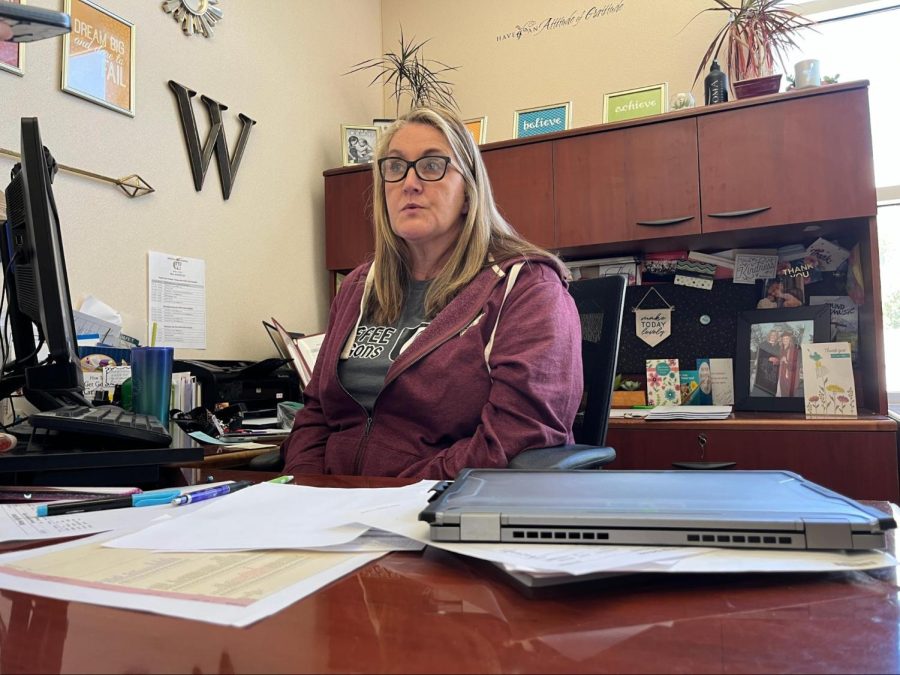College process takes its toll on seniors
Following the application season, junior guidance counselor Mrs. Roisin Leroy shares how students apply to colleges and what it entails. With an estimated 70% of students applying to at least one University of California school, Mrs. Leroy talked about the amount of hours and essays students had to put in to apply. Photo by Isabel Soto
Seniors all over the country are learning if they got into the colleges they applied to. As they are viewing their acceptances, they are considering committing to one of the schools. The nationwide deadline for college enrollments is May 1.
As every new letter of acceptance or denial is opened, seniors get ready to embark on a new chapter of their lives after high school.
“I think it’s very stressful, and students put a lot of stress on themselves. It’s their senior year. A lot of them are taking AP courses or dual enrollment courses. So not only do they have the school stress, but then they also have this pressure to get into these colleges,” College and Career Advisor Ms. Alyssa Pacay said.
Most college applications opened from August to October, and depending on which school students chose, the application window closed during November. The 70% of seniors who applied to UC’s were given access to applications Aug. 1 but were not able to submit them until Oct. 1. Each school had a different application process, but most colleges had similar elements that were required for every student to successfully apply.
One of the crucial requirements for most colleges is an essay written based on the prompts given. Though students have several months to complete the essays, prompts call for analytical thinking of one’s experiences and can only be expressed in a limited amount of words, a limit that can range anywhere from 100 words to upwards of 750.
“Learning how to convey the activities I did and the things I was passionate about was very stressful. Because I have a limited amount of space and such a low word count in the essays, I really struggled to fit in everything and choosing what was most important was difficult,” Marina Parker said.
Many seniors spent around two to three hours everyday working on their applications, making sure their essays and forms were accurate and impressive. In addition to demonstrating their writing and reflection skills, students included details of their work, volunteer and extracurricular involvement.
“The whole process of quantifying yourself and selling yourself to colleges felt a little bit dehumanizing. At the end of the day, admission officers are going to look at you as a statistic. It’s like comparing the things you’re passionate about and your activities to another candidate and deciding whose are more impressive,” Parker said.
Students not only had to think about the aspects of their education, but also the concept of convenience and money.
“Applying to college is very stressful, and also very expensive. I applied to nine colleges, and it cost me over $500 to pay for it,” Maddox Rivera said.
Students like Rivera paid between $30 and $90 per college application. The process of work and then paying to showcase it all could lead to one of three options – admission, rejection or a space on the waitlist.
“A lot of the prestigious colleges this application season denied a lot of people. It’s like nobody got in,” Rivera said.
Applying and getting rejected from a school can be tough, however there are ways to remain positive.
“It’s important for students to remember that they’re more than a college acceptance letter. And just because one college may not accept them, that doesn’t mean that they’re not a good student,” Pacay said.
“Students might not be the right fit for a specific school, but it’s crucial to acknowledge that there’s more to life than getting accepted into a college,” Pacay said.
“Managing stress goes along with finding self care and activities that they can do to either take their minds off of it or heal themselves from the weight of college applications,” Pacay said.
Through the process of applying to colleges, seniors had gone through hours of revision. The culmination of work they had done in their years of high school would contribute to the feedback they get from colleges.
Rivera said, “I felt disappointed getting rejected, but it wasn’t a life-ruining event. I was accepted to some good colleges that I really wanted to go to and I was also rejected to some that I really wanted to go to. There’s good and bad, but as long as you get into some, you’ll be okay. Life goes on.”
by WYNETTE CALUNSAG & ISABEL SOTO









